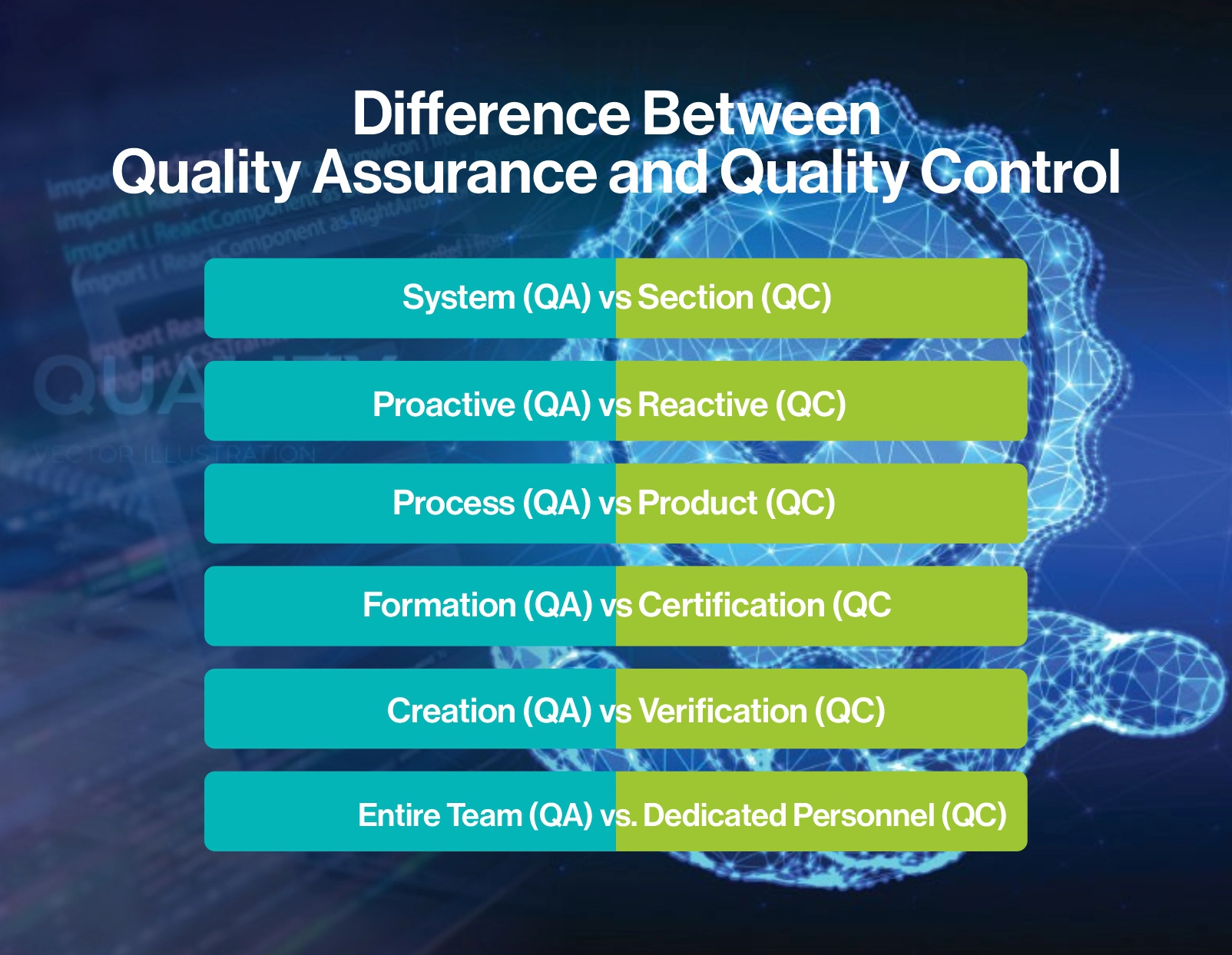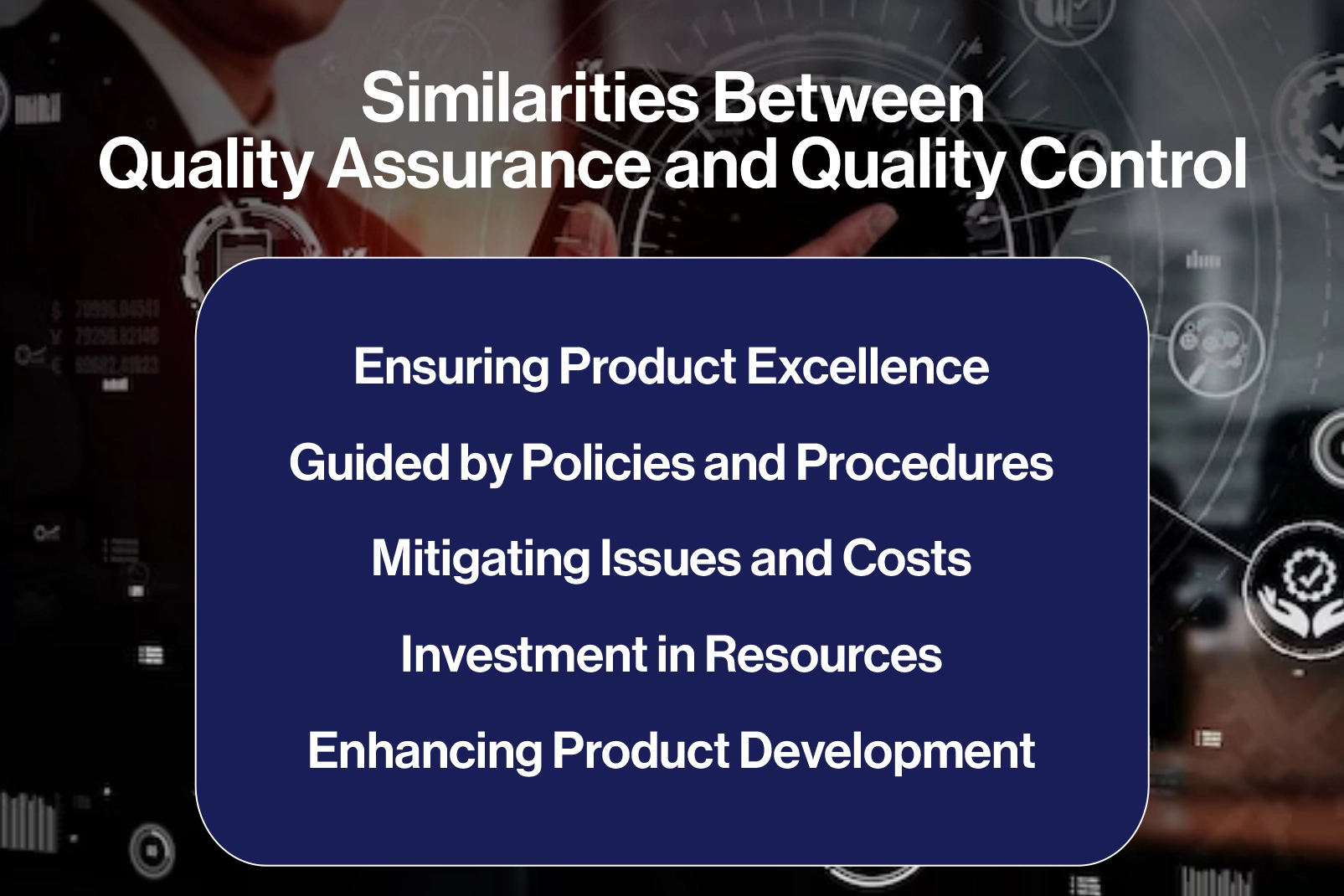Ready for Quality control vs Quality assurance??
Nowadays, just adopting digital changes isn’t the final step. Everything happens in the digital realm, whether it’s buying something online, sorting out insurance papers, or making payments. So, companies need to step up and provide incredible online experiences. This isn’t just about keeping users interested; it’s about making them stick around, love the service, and keep coming back; that’s how businesses grow online.
Now, when it comes to making these digital experiences top-notch, companies usually take two main paths: quality assurance (QA) and quality control (QC). Quality Assurance (QA) and Quality Control (QC) are two different terms often used interchangeably. However, there are clear differences in both these concepts.
QA is process-oriented and concentrates on fault avoidance or prevention, whereas QC is product-oriented and spotlights fault detection or discovery. Let’s have a look at quality control vs quality assurance!
What is Quality Assurance?
We are talking about quality control vs quality assurance. Lets talk first about Quality assurance (QA) involves a series of actions and protocols known as quality standards. These are implemented during and after product development or project management. Its main goal is to guarantee the creation of a top-notch product or the achievement of a successful project outcome, especially in IT outsourcing services. QA addresses issues customers might encounter after launching a product or service. It encompasses overseeing the progress of a project or product towards its completion while ensuring that an organization or team sticks to specific standards or guidelines.
What is Quality Control?
We are talking about quality control vs quality assurance. Let’s talk about Quality control (QC) occurs after a product has been developed and manufactured. It involves examining product development or project completion outcomes to verify if they align with the predetermined quality standards. QC operates reactively, identifying and addressing issues that arise, such as software glitches or imperfections, and aiming to rectify them. By doing so, QC plays a crucial role in ensuring that a high-quality product is delivered to consumers, minimizing potential flaws before reaching the market. Organizations usually adopt a structured method for conducting QC on their products.
Difference Between Quality Assurance and Quality Control
Quality assurance involves establishing guidelines, policies, and procedures to craft a superior product and prevent defects. Conversely, quality control entails reviewing the product during production to ensure it meets stringent standards. QA spans the entire process, from planning to ongoing maintenance, whereas QC is primarily conducted during the inspection phase.
The best software outsourcing companies ensure that they adhere to all the aspects of quality assurance and quality control.
Moreover, QA is proactive, concentrating on refining processes throughout development, while QC reacts to identified glitches or issues, focusing more on the final product. Additionally, QA is a responsibility that extends across the organization, while QC duties typically fall to smaller, specialized teams focused on testing the product.
Read our guide:
In-House Vs Outsourcing Software Development
Emphasis:
QA seeks to avoid faults with an emphasis on the procedure used to produce the product. It is a pre-emptive (proactive) value procedure.
QC seeks to detect (and correct) faults in the completed product. Quality control, hence, is a permissive (proactive) procedure.
Target:
The target of QA is to enhance development and assessment procedures so that flaws do not occur while the product is being formed or used.
The target of QC is to detect faults next to a product being formed and before it’s released.
How:
QA determines a great quality supervision scheme and the evaluation of its competence. Regular conformance checks or reviews of the functions of the structure.
QC Locating & eliminating causes of quality issues through means & gear so that customer’s constraints are constantly met.
What:
QA: Inhibition of quality issues through scheduled and organized actions including documentation.
QC: The actions or skills used to attain and sustain the product’s worth, procedure, and provision.
Numerical Methods:
In QA, numerical means and methods are used in procedures (procedure inputs & functioning factors) that are named Statistical Process Control (SPC) and come under QA.
In QC, numerical means and methods are used to complete products (process outputs) and are named Statistical Quality Control (SQC).
As a tool:
QA is an administrative tool.
QC is a remedial tool.
Activity determined:
QA activities are determined before production work starts, and these endeavors are accomplished while the product is being developed.
QC activities are carried out after the product is developed.
System (QA) vs Section (QC)
QA control systems are the practices and processes which are applied to maintain quality criteria. Quality control systems calculate parts involving the outputs of the system.
QC attempts may also be centered on parts applied to generate the ultimate product, such as raw materials from a contractor. The QA system for quality management may influence several pursuits to ensure inputs are constantly reliable and successful, such as inspecting contractors and batch sampling raw materials.
Proactive (QA) vs. Reactive (QC)
Being proactive is at the heart of effective quality assurance (QA). Its main focus is on preventing defects by designing processes that nip potential issues in the bud. Conversely, quality control (QC) is reactive; it steps into spot and address defects after they’ve cropped up in the product. Hence, ensuring low IT outsourcing costs.
QA revolves around process design, such as crafting clear standard operating procedures (SOPs) aligned with ISO 9000 standards. Following these processes should ideally yield a consistently safe and effective product. Conversely, QC involves rigorous product testing to ensure it meets safety and efficacy benchmarks. If QC detects quality concerns, immediate steps are taken to prevent the distribution of an unsafe product.
QC findings must trigger a review by QA. Any deviation in test results should prompt a comprehensive investigation, known as corrective and preventive action (CAPA), to identify the root cause of quality issues. This leads to necessary process updates, aiming to prevent similar problems.
Process (QA) vs. Product (QC)
Quality assurance (QA) primarily centers on processes, aiming to avert quality problems. On the other hand, quality control (QC) directs its attention to products, seeking to pinpoint any quality issues in manufactured goods that might impact customer satisfaction. It’s essentially about actions versus outcomes – QA involves the actions involved in creating the product, while QC is all about assessing the resulting product. Here are specific examples of each:
QA Processes:
- Documentation procedures
- Conducting audits
- Managing suppliers
- Training personnel
- Implementing change control measures
- Developing investigation protocols
QC Procedures:
- Inspecting batches of products
- Sampling products for evaluation
- Conducting validation tests
- Performing laboratory tests
- Carrying out software testing
Formation (QA) vs Certification (QC)
The consequence of QA actions is a roadmap for producing high-quality products. It entails specifying criteria for product layout, fabrication, packing, delivery, promotion, and deals.
QC entails confirmation of products’ post-production supply, verification, security, and value.
Creation (QA) vs. Verification (QC)
In quality assurance (QA), the focus lies on creating a blueprint for crafting high-quality products. This encompasses setting standards across various stages, from product design and manufacturing to packaging, distribution, marketing, and sales.
On the other hand, quality control (QC) is all about verifying products after manufacturing but before distribution, ensuring their safety and efficacy align with established standards.
Entire Team (QA) vs. Dedicated Personnel (QC)
In a quality assurance (QA) scenario, the whole team within a life sciences organization plays a role. Each member holds responsibility for QA by adhering to Standard Operating Procedures (SOPs). Although the quality management system (QMS) falls under the purview of the quality unit and leadership, QA activities encompass training, documentation, and reviews across the entire workforce.
Conversely, quality control (QC) typically falls under the jurisdiction of dedicated personnel within the organization. Their specific responsibilities involve following SOPs for product testing. QC staff diligently adhere to SOPs for quality control, meticulously documenting their findings based on standardized product testing and process validation procedures.
Defect Prevention vs. Defect Identification
By emphasizing robust development practices and quality-oriented approaches like test-driven development, tech outsourcing companies aim to minimize the influx of defects into the Quality Control (QC) stage, further reducing the chances of these issues reaching customers. Quality Assurance (QA) takes the proactive stance, striving to avert defects altogether. This involves fostering collaborative practices among teams and implementing measures such as thorough code reviews to nip potential issues in the bud.
Conversely, in Quality Control, testers diligently detect and prioritize the defects that persist despite preventive efforts. While the approaches and emphases differ between QA and QC, their ultimate objective remains identical: to ensure a superior, defect-free end product for the customers.
Industry Outlooks on QA and QC
For some service organizations, the concept of quality control may be foreign because there is no tangible product to inspect and control. The quality assurance function in a service organization may not include quality control of the service but may include quality control of any products involved in providing the service.
A service may include documents (such as a report, contract, or design) or real products. It may be essential to monitor product quality in a service company to guarantee that the service meets customer obligations.
QA, QC, and Checkup
Scrutiny is the procedure of quantifying, investigating, and checking to determine one or more attributes of a product or service and the contrast of these with the need to verify conformity. Products, procedures, and several other outcomes can be examined to make sure that the thing coming off a production line or the service being offered is accurate and meets requirements.
Quality Assurance and Audit Tasks
Auditing is a component of quality assurance tasks. It is essential to ensure quality because it is used to compare real situations with needs and to inform the findings to the administration.
Similarities Between Quality Assurance and Quality Control
Every business aims to steer clear of delivering a subpar product. Putting customers first is key, whether it’s a tech giant or a local bakery. Quality assurance and quality control might seem like opposites at times, but they’re more like teammates working toward the same goal, ensuring top-notch products. They might have different roles, but think of them as partners in crime, not rivals. After all, both QA and QC have a common aim: to uphold high standards and keep customers happy and loyal.
Ensuring Product Excellence
Businesses can’t merely cross their fingers and hope for the best. QA lays the groundwork, outlining strategies for achieving digital quality, while QC steps in to confirm the end product meets the mark. Together, they’re the guardians of ensuring top-notch products reach customers, securing business revenue.
Guided by Policies and Procedures
While QA leans towards process-oriented frameworks compared to QC, both adhere to organizational standards to ensure high quality. QC might involve more inventive testing approaches, like fringe or UX testing, demanding tester creativity. However, systematic defect detection and resolution remain central.
Mitigating Issues and Costs
Defects aren’t just inconveniences; they can spell disaster for businesses. Catching and resolving defects early significantly reduces costs. As defects edge closer to customers, the risks magnify. QA establishes policies for early detection, while QC diligently hunts and fixes bugs in developed products.
Investment in Resources
Whether it’s internal teams for QC and QA or seeking external testing support, skimping on digital quality may backfire. Invest in skilled personnel and robust tools across the organization. While release timelines are tight, comprehensive test coverage is crucial. Rushing QA and QC isn’t worth the risk.
Enhancing Product Development
Continuous learning is key. QC and QA are feedback loops, enabling organizations to continually refine processes. They offer invaluable insights into areas for improvement, be it in bug detection, test automation, requirement gathering, or enhancing user experiences.
Also, read:
Saas Product Development Benefits
Conclusion
So here is the final thoughts of quality control vs quality assurance, QC and QA should be used at the same time, and they’re most excellent when both are integrated into an enterprise quality management system (eQMS) for end-to-end excellence developments and processes.
In short, Quality Assurance (QA) belongs to the method used to produce the product and can be executed by an administrator, user, or a third-party assessor. Cases of quality assurance consist of method checklists, task inspections, and procedure and specifications growth.
Quality Control (QC) belongs to quality-linked pursuits connected with the production of products. Quality control is applied to prove that products are of appropriate value and that they are perfect and precise. Examples of quality assurance actions consist of scrutiny, deliverable contemporary appraisals, and the scanning procedure.
If you want to partner up with the best IT outsourcing service companies, then you can reach out to FiveRivers Technologies. With over 20 years of experience in providing custom software development services, FiveRivers Technologies stands among the top software projects outsourcing companies.
This the brief information about quality control vs quality assurance.









